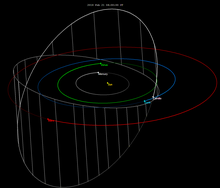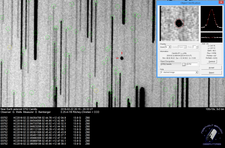3752 Camillo is an inclined contact-binary asteroid, classified as near-Earth object of the Apollo group, approximately 2.3 kilometers (1.4 miles) in diameter. It was discovered on 15 August 1985, by astronomers Eleanor Helin and Maria Barucci using a 0.9-metre (35 in) telescope at the CERGA Observatory in Caussols, France. Lightcurve studies by Petr Pravec in 1998 suggest that the assumed S-type asteroid has an elongated shape and a longer-than average rotation period of 38 hours.[1][4]
Orbit

Camillo orbits the Sun at a distance of 0.99–1.8 AU once every 20 months (614 days; semi-major axis of 1.41 AU). Its orbit has an eccentricity of 0.30 and an inclination of 56° with respect to the ecliptic.[3]
Close approaches
The closest point between the orbit of the Earth and the orbit of this asteroid (Earth MOID) is currently 0.0780 AU (11,670,000 km; 7,250,000 mi) or 30 lunar distances,[3] so Camillo does not come close enough to Earth to qualify as a potentially hazardous asteroid. It came to perihelion (its closest approach to the Sun) on 6 January 1976 and, on 17 February 1976 and passed within 0.08013 AU (11,987,000 km; 7,449,000 mi) of Earth.[3]
2013 passage
Camillo came to perihelion on 27 December 2012.[3] On 12 February 2013 the asteroid passed 0.14775 AU (22,103,000 km; 13,734,000 mi) from Earth[3] and had an apparent magnitude of 13.[4] During the 2013 passage the asteroid was studied by radar using Goldstone and Arecibo.[4]
 Camillo's south to north daily motion in the sky as seen from the earth |
2018 passage
On February 20, 2018, the asteroid passed by Earth. It was observed on radar by Arecibo Observatory and shown to have a long angular double-lobed shape.[11] At 0.13 AU (19,000,000 km; 12,000,000 mi) distance its peak magnitude was about 13.
 Camillo's south to north daily motion in the sky as seen from the earth |
Naming
This minor planet was named for the son of the early Roman King Turno. "Camillo" is also the name of the discoverer's son.[2] The official naming citation was published by the Minor Planet Center on 20 May 1989 (M.P.C. 14633).[14]
References
- ^ a b c "3752 Camillo (1985 PA)". Minor Planet Center. Retrieved 10 May 2018.
- ^ a b Schmadel, Lutz D. (2007). "(3752) Camillo". Dictionary of Minor Planet Names – (3752) Camillo. Springer Berlin Heidelberg. p. 317. doi:10.1007/978-3-540-29925-7_3749. ISBN 978-3-540-00238-3.
- ^ a b c d e f g h "JPL Small-Body Database Browser: 3752 Camillo (1985 PA)" (2018-05-03 last obs.). Jet Propulsion Laboratory. Retrieved 10 May 2018.
- ^ a b c d e Lance A. M. Benner (15 November 2012). "3752 Camillo Goldstone Radar Observations Planning". NASA/JPL Asteroid Radar Research. Retrieved 23 November 2012.
- ^ a b c Mainzer, A.; Grav, T.; Masiero, J.; Hand, E.; Bauer, J.; Tholen, D.; et al. (November 2011). "NEOWISE Studies of Spectrophotometrically Classified Asteroids: Preliminary Results". The Astrophysical Journal. 741 (2): 25. arXiv:1109.6407. Bibcode:2011ApJ...741...90M. doi:10.1088/0004-637X/741/2/90. S2CID 35447010. (catalog)
- ^ a b Mainzer, A.; Grav, T.; Bauer, J.; Masiero, J.; McMillan, R. S.; Cutri, R. M.; et al. (December 2011). "NEOWISE Observations of Near-Earth Objects: Preliminary Results". The Astrophysical Journal. 743 (2): 17. arXiv:1109.6400. Bibcode:2011ApJ...743..156M. doi:10.1088/0004-637X/743/2/156. S2CID 239991.
- ^ a b c Pravec, Petr; Harris, Alan W.; Kusnirák, Peter; Galád, Adrián; Hornoch, Kamil (September 2012). "Absolute magnitudes of asteroids and a revision of asteroid albedo estimates from WISE thermal observations". Icarus. 221 (1): 365–387. Bibcode:2012Icar..221..365P. doi:10.1016/j.icarus.2012.07.026.
- ^ a b c "LCDB Data for (3752) Camillo". Asteroid Lightcurve Database (LCDB). Retrieved 10 May 2018.
- ^ a b Pravec, Petr; Wolf, Marek; Sarounová, Lenka (November 1998). "Lightcurves of 26 Near-Earth Asteroids". Icarus. 136 (1): 124–153. Bibcode:1998Icar..136..124P. doi:10.1006/icar.1998.5993.
- ^ Hanus, J.; Durech, J.; Oszkiewicz, D. A.; Behrend, R.; Carry, B.; Delbo, M.; et al. (February 2016). "New and updated convex shape models of asteroids based on optical data from a large collaboration network". Astronomy and Astrophysics. 586: 24. arXiv:1510.07422. Bibcode:2016A&A...586A.108H. doi:10.1051/0004-6361/201527441. S2CID 119112278.
- ^ "Radar images of 3752 Camillo". Arecibo Observatory (on Twitter). 21 February 2018.
- ^ Wells, G.; Bamberger, D. (22 February 2018). "3752 Camillo". Northolt Branch Observatories. Retrieved 10 May 2018.
- ^ Wells, G.; Bamberger, D. (22 February 2018). "Near Earth asteroids 2017 VR12, 3752 Camillo, 2018 CU1 and 2018 DA". Northolt Branch Observatories. Retrieved 10 May 2018.
- ^ "MPC/MPO/MPS Archive". Minor Planet Center. Retrieved 10 May 2018.
External links
- Asteroid Lightcurve Database (LCDB), query form (info Archived 16 December 2017 at the Wayback Machine)
- Dictionary of Minor Planet Names, Google books
- Asteroids and comets rotation curves, CdR – Observatoire de Genève, Raoul Behrend
- 3752 Camillo at NeoDyS-2, Near Earth Objects—Dynamic Site
- 3752 Camillo at ESA–space situational awareness
- 3752 Camillo at the JPL Small-Body Database











You must be logged in to post a comment.